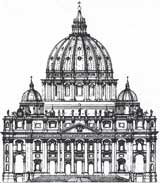St. Peter's - Works by Sangallo and Michelangelo
Peruzzi's work at St. Peter's Basilica was cut off in 1536, not without suspicion of having been poisoned by one who hoped to succeed him in his office. Antonio Sangallo took charge of the affairs and restudied the whole matter.

St. Peter's Basilica
Looking at Sangallo's plans, the exterior has much merit, but the plan little or none, compared with those which had already been made. Though retaining the Greek cross principle of Peruzzi, he proposed to add a great and well-nigh useless hall or vestibule flanked by two great campanili, giving to the exterior the form of the Latin cross. It is probable, however, that he had little opportunity of making headway with the scheme, his time being occupied in building up the niches of the great piers of the dome, and possibly by the inner wall of the southern apse, which, after it had been thickened by Michelangelo, became the outer wall of his restricted plan.
Sangallo's design of the Basilica was freely criticized and generally condemned by his contemporaries, who rarely appear to have done Antonio justice. Michelangelo was especially critical, and is said to have banned the design because, broken up "with its innumerable projections, pinnacles, and divisions of members, it was more like a work of the Teutons than of the good antique manner, or of the cheerful and beautiful modern style." As for Antonio's capacity to carry out such a work, Vasari says: "It is true that he effected much, in accomplishing what we possess; but he would, nevertheless, as is believed, have seen his way more clearly through certain of the difficulties incidental to that work, had he performed his labours in company with Baldassare."
Michelangelo's design
Antonio died in 1546, at sixty-one years of age, and Michelangelo, ten years his senior, succeeded him at St. Peter's Basilica. He reduced the scheme greatly, and by suppressing many of the features of the designs both of Peruzzi and Antonio, gave the plan a simplicity on a great scale.
He was, however, strong enough to overcome prejudice and restore the plan of the equal arms. The cliff-like walls of the apses and the towering pilasters, as we know them, are his work, as is also the dome, for which he left a complete model and drawings.
These parts of Saint Peter's, however, properly belong to the succeeding or Late Period, which Michelangelo really initiated, and the extension of the nave, which ended the battle between the two forms of cross, belongs to the 17th Century.
The façade exhibits Carlo Maderna's work, with a base caricature of the portico which Michelangelo had designed to stand free of the main building as an appendage to the Greek cross scheme, but which the 17th Century architect made to stick close to the wall. Later still are the great Doric colonnades surrounding the piazza, which were begun in 1667 under Bernini.
More on St. Peter's: